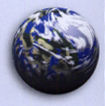
Star Trek Star Charts (Pocket, 2002) by Geoffrey Mandell positions the Andorian Empire on Andoria, or Procyon VIII (Alpha Canis Minoris), in the Beta Quadrant. By the time of Earth's 24th century, Andoria has a population of 38.2 billion. The Andorians became a warp capable people in 1154 AD (Earth date).
The Worlds of the Federation (Pocket, 1989) by Shane Johnson gave the native name of the homeworld as Fesoan. The Andorians: Among the Clans (Last Unicorn Games, 1999) disagreed with many previous assumptions about Andoria; this manual suggests that Andoria is an ice-covered planet in orbit around a blue-white giant star, not an orange one [Star Trek Maps (Bantam, 1980)], and debunks all previous non-canonical works as mythology. A follow-up work revises this information, with Andoria said to be fifth world out from the star Kuy'va. [Star Trek Roleplaying Game: Narrator's Guide (Decipher, 2002)].
Originally, the Starfleet Technical Manual (Ballantine, 1975) by Franz Joseph identified the Andorian home planet to be Epsilon Indi VIII, a star in the constellation of Indus the Indian (as seen from Earth). Note that this publication is no longer considered accurate, although Epsilon Indi VIII and Epsilon Indi IV may well be major Andorian colony worlds. Population was estimated at 17.2 billion (Earth's 23rd century) in Introduction to Navigation by John Upton [contained in Star Trek Maps (Bantam, 1980)]. The galactic coordinates were supposedly: 25.8, 60.1, -2.4.
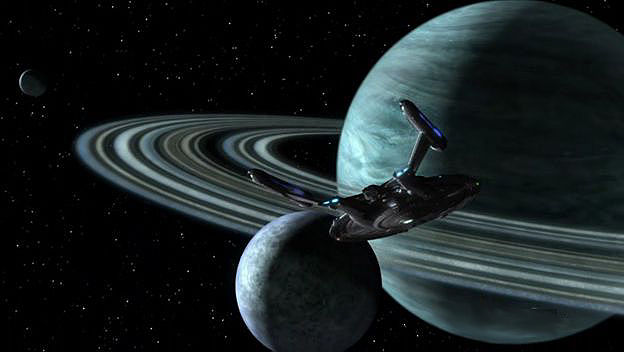
Andoria is an ice-encrusted moon. [Enterprise: The Aenar.]
The land-to-water ration is 15:85 and the Andorian oceans are sources of food, industrial energy and scientific inquiry, not recreation. There are two main continents on Andor, one being Zhevra. The tip of Thelasa-vei Province is called the Hand of Cheshras, where four major rivers converge to create five fingers of land. Harbortown is its primary city and Andor's oldest and third largest metropolis. It is situated on the largest peninsular, between the Frost and Moss Rivers. A city of slanted office towers and high-rise residences, Harbortown's original settlement began in a porous network of caves. Thirteen centuries ago, there was a poisonous gas build up which seeped into homes but, at first, no connection was made as to the cause of mysteriously random deaths of the citizens. The Nitra Bridge to Harbortown crosses over the Frost River. Other locations on Andor include: Vezhdar Plain, the Great Rift Range, Shayel Island, Cheshras Island, the Eastern Archipelago, the town of Wethesa, and the Khyzhon Sea. Shops in the Shess neighbourhood are mostly underground, with only the tops of the first floor visible. Other Andorian landmarks are the Grand Staircase and Central Canal. [Andor: Paradigm by Heather Jarman in Worlds of Deep Space Nine, Book 1 (Pocket, 2004).]
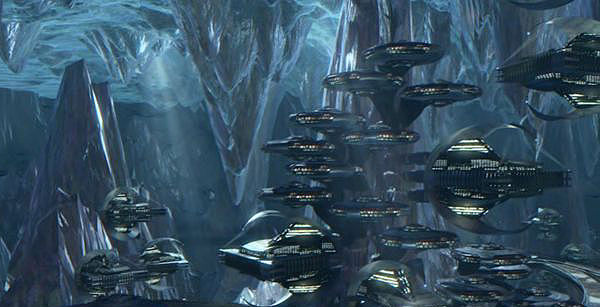
The rare Aenar subspecies now occupies only an ancient, underground Andorian city. [Enterprise: The Aenar.]
The Andorians created havoc at the first Babel Conference, called to incorporate the United Federation of Planets. It seems they claimed "sovereignty over all stars visible to the eye from Andor". Thiptho lapth is a common Andorian greeting. [Spaceflight Chronology (Pocket, 1980) by Stan and Fred Goldstein.]
Sissalya cycles coincide with an ancient dance routine performed at the autumn solstice. [The Next Generation: The Devil's Heart (Pocket, 1993) by Carmen Carter.] In the ancient Hill Country, the passing of time is usually counted in cycles, rather than years. Nightfall signifies the beginning of Deepening. In the typhoon season, ionization of the Andorian atmosphere rises dramatically, to a degree seldom seen on other Class-M worlds. [Andor: Paradigm by Heather Jarman in Worlds of Deep Space Nine, Book 1 (Pocket, 2004).]

 The Starfleet Technical Manual by Franz Joseph (Ballantine, 1975) features an Andorian official seal and a flag, with colour guides. (A colourised version of the Epsilon Indi VIII seal is featured at left.) Population was estimated at 17.2 billion (Earth's 23rd century) in Introduction to Navigation by John Upton [contained in Star Trek Maps (Bantam, 1980)]. The galactic coordinates were supposedly: 25.8, 60.1, -2.4.
The Starfleet Technical Manual by Franz Joseph (Ballantine, 1975) features an Andorian official seal and a flag, with colour guides. (A colourised version of the Epsilon Indi VIII seal is featured at left.) Population was estimated at 17.2 billion (Earth's 23rd century) in Introduction to Navigation by John Upton [contained in Star Trek Maps (Bantam, 1980)]. The galactic coordinates were supposedly: 25.8, 60.1, -2.4.
During an encounter with an entity known as The Gorgan, Spock of the Enterprise revealed that Triacus, site of a former band of marauders centuries earlier, is in the Epsilon Indi system. [And the Children Shall Lead] Perhaps Andorians were among those who joined in the legendary vengeance against their conquerors?
A race manifest lists Andor as being in the Espilson Indi system. [The Great Starship Race (1993) by Diane Carey.]
Andorii is the native tongue of the Andorians. [Deep Space Nine: Section 31: Abyss (Pocket, 2001) by David Weddle and Jeffrey Lang.] Alternatively, it is known as Graalen. [Star Trek Roleplaying Game: Narrator's Guide (Decipher, 2002)].
Legally, Andor has a constitutional monarchy, but there has been no single ruler on the so-called Empty Throne for five centuries. Queen Thalisar the Last deliberately died childless. Her actions led to the abolishment of clan warfare. She brokered peace on the site of what is now The Plaza of Freedom in Andor's capital city. This is an octagonal public space which contains fountains, towering leaves of translucent green mica from the Archipelago and a cerulean blue obelisk to the memory of Shran. [Andor: Paradigm by Heather Jarman in Worlds of Deep Space Nine, Book 1 (Pocket, 2004).]
Commander Deanna Troi, of the USS Titan, looked to the speeches of Thalisar and the poetry of Shran for inspiration when that ship's dedication plaque was being brainstormed. [Titan: The Red King (Pocket, 2005) by Andy Mangels and Michael A Martin.]
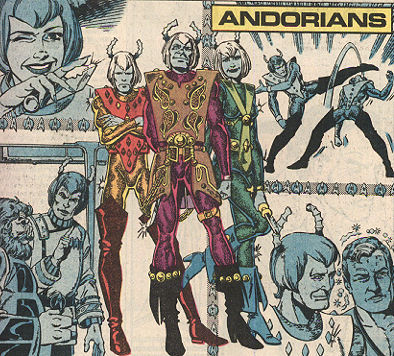 |
Andorian artwork from DC Comics' Who's Who in Star Trek.
There are two prominent political parties on Andor: the Visionist Party and the Modern Progressives. The Parliament Andoria complex contains the Heroes' Antechamber, an eight-sided room, with four walls dominated by the carved faces of the mythological Guardians, who supposedly study all those approaching the Grand Chamber. Footwear must be removed and the eyelids, nose, tongue, ears and antennae are ritually anointed with sweet-smelling oil to seal the senses from treachery. [Andor: Paradigm by Heather Jarman in Worlds of Deep Space Nine, Book 1 (Pocket, 2004).]
In Andorian mythology, The Tale of the Breaking tells of Thirishar the Warrior, the Greatest Among Mortals. When he approached the gatekeeper of Uzaveh the Infinite, he was permitted to walk the Path of Light. Assuming he was entitled to claim the Empty Throne, the Throne of Secrets, beside the Infinite, Thirishar was told he was not worthy and not yet Whole. From Thirishar, Uzaveh created the First Kin, four separate beings. Each one was banished to the four farthest reaches of the kingdom, accompanied only by a Guardian. The beings were: Charaleas (representing wisdom, guided by the stars as Guardian); Zheusal (strength, protected by the earth); Shanchen (blood, a vessel for the Water Spirit); and Thirizaz (passion, guarded by the Fire Daemon). This story is told in The Liturgy of the Temple of Uzaveh, Third-Century Codex. [Andor: Paradigm by Heather Jarman in Worlds of Deep Space Nine, Book 1 (Pocket, 2004).] Also summarised during an Aenar shelthreth ceremony in [The Good That Men Do (Pocket, 2007) by Andy Mangels and Michael A Martin.]
A commonality in Andorian myths is that Andorians lack a piece of self knowledge which makes them unworthy of evolving beyond who or what they are. Nothing in the natural animal or plant biology, or fossil record, of Andor indicated an origin for sentient Andorians' unique four-gender paradigm. Until recently, a growing number of theorists have speculated that Andorians may not have evolved on the planet they consider to be their home world. Were they originally space-faring refugees from a dying planet? [Andor: Paradigm by Heather Jarman in Worlds of Deep Space Nine, Book 1 (Pocket, 2004).]
The Starfleet Medical Reference Manual (Ballantine, 1977) by Eileen Palestine features speculative information about Andorian physiology. However, some of this information has been discovered to be incomplete or incorrect. For example, according to the manual, Andorians do not have external flapped ears like human beings, and their visual colour receptors (cones) are supposedly located in the antennae. The eyes are capable of seeing only in monochrome. Palestine's suggestion that Andorians have a partial exoskeleton has not been supported by "canonical" (aired) evidence. An Andorian named Sharav is shown with a partial exoskeleton in The Dragons of Berengaria: Part Two comic story by Brian Franczak [in Enterprise Incidents #8, 1980].
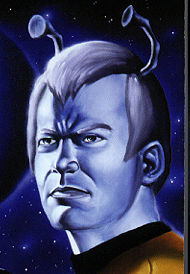 In an Andorian, unfocussed eyes and a failure to respond to external stimuli, are symptoms of Eadiliac failure. The eadilium is a unique Andorian organ. Unlike many other hominids, Andorian sexual organs are not external. [The Next Generation: The Devil's Heart (Pocket, 1993) by Carmen Carter.]
In an Andorian, unfocussed eyes and a failure to respond to external stimuli, are symptoms of Eadiliac failure. The eadilium is a unique Andorian organ. Unlike many other hominids, Andorian sexual organs are not external. [The Next Generation: The Devil's Heart (Pocket, 1993) by Carmen Carter.]
In Last Unicorn Games' setting book, The Andorians: Among the Clans (Last Unicorn Games, 1999) by S. John Ross, Steven S. Long and Adam Dickstein, Andorians are described as hominids who underwent symbiogenesis early in their evolution. Much life on Andoria has characteristics of insectoid life. Three races of Andorians are identified: the predominant Thalassan, with high, knobby antennae; Talish, who have forward, tendril-like antennae; and Bish'ee, who have diminishing antennae standing straight out from their head.
A speculative discussion of the evolution of Andorian antennae can be found in Life Signs: The Biology of Star Trek (HarperCollins, 1998) by Susan and Robert Jenkins.
Andorian society is highly structured, but the race has a genetic predisposition toward violent behaviour. Imminent danger causes a biochemical reaction to danger, resulting in either physical violence or an increase in sensory input levels which, in turn, can enhance analytical and reasoning skills. Andorians do not succumb easily to pressure and actually get calmer in a crisis - until they get violent. [Deep Space Nine: Avatar, Book 2 (Pocket, 2001) by SD Perry.]
The proximity of hominids can produce a "pins-and-needles" sensation in the antennae. [Deep Space Nine: Section 31: Abyss (Pocket, 2001) by David Weddle and Jeffrey Lang.]
2003 Andorian cover art competition
Star Trek's Lower Decks: a novel approach
A Rogues' Gallery of Bolians, the other blue-skinned race
Races of the United Federation of Planets
Toon Trek: References to Filmation's Star Trek: The Animated Series in latter day tie-ins
Most Andorian graphics © Paramount Pictures Corp., Pocket Books, Ballantine Boooks, DC Comics and Last Unicorn Games. Reproduced for research purposes only. This web page is not intended to infringe on copyrights held by Paramount/Viacom.
Page revised March 2007
URL: http://www.geocities.com/therinofandor/index.html
Email Therin and Ian at: [email protected]